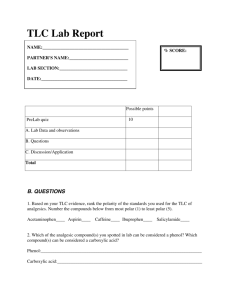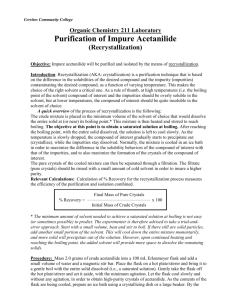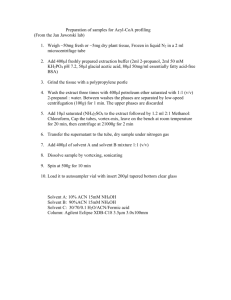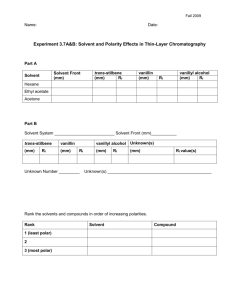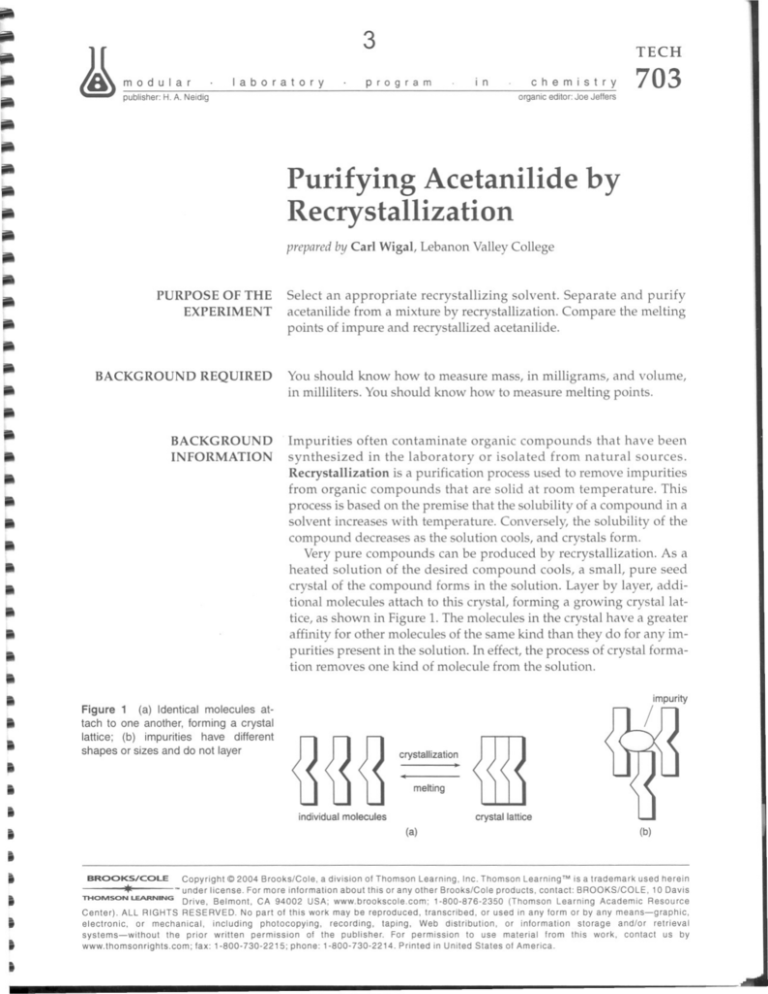
...
3
...
..
..
..
modular
publisher:
laboratory
.
...
prepared
by Carl Wigal, Lebanon Valley College
Select an appropriate recrystallizing solvent. Separate and purify
acetanilide from a mixture by recrystallization. Compare the melting
points of impure and recrystallized acetanilide.
BACKGROUND REQUIRED
You should know how to measure mass, in milligrams, and volume,
in milliliters. You should know how to measure melting points.
..
BACKGROUND
INFORMATION
Ii
Ii
..
8
Figure
tach to
lattice;
shapes
Impurities often contaminate organic compounds that have been
synthesized in the laboratory or isolated from natural sources.
Recrystallization is a purification process used to remove impurities
from organic compounds that are solid at room temperature. This
process is based on the premise that the solubility of a compound in a
solvent increases with temperature. Conversely, the solubility of the
compound decreases as the solution cools, and crystals form.
Very pure compounds can be produced by recrystallization. As a
heated solution of the desired compound cools, a small, pure seed
crystal of the compound forms in the solution. Layer by layer, additional molecules attach to this crystal, forming a growing crystallattice, as shown in Figure 1. The molecules in the crystal have a greater
affinity for other molecules of the same kind than they do for any impurities present in the solution. In effect, the process of crystal formation removes one kind of molecule from the solution.
1 (a) Identical molecules atone another, forming a crystal
(b) impurities have different
or sizes and do not layer
crystallization
..
..
melting
..
individual molecules
8
I
a
a
D
D
t
703
editor: Joe Jeffers
PURPOSE OF THE
EXPERIMENT
..
8
8
..
..
..
chemistry
organic
Purifying Acetanilide by
Recrystallization
i8
..
..
..
ra
ra
..
..
..
in
program
H. A. Neidig
..
..
TECH
crystal lattice
(a)
(b)
BROOKS/COLE
Copyright @2004 Brooks/Cole, a division of Thomson learning, Inc. Thomson learningTM is a trademark used herein
*
under license. For more information about this or any other Brooks/Cole products, contact: BROOKS/COLE, 10 Davis
THOMSONLEARNING Drive, Belmont, CA 94002 USA; www.brookscole.com; 1-800-876-2350 (Thomson learning Academic Resource
Center). All RIGHTS RESERVED. No part of this work may be reproduced, transcribed, or used in any form or by any means-graphic,
electronic, or mechanical, including photocopying, recording, taping, Web distribution, or information storage and/or retrieval
systems-without
the prior written permission of the publisher. For permission to use material from this work, contact us by
www.thomsonrights.com; fax: 1-800-730-2215; phone: 1-800-730-2214. Printed in United States of America.
32
TECH 703: Purifying Aceranilide by Recrysrallization
Selecting an appropriate recrystallizing solvent to use is probably the
most difficult step of recrystallization. The primary consideration when
choosing a recrystallizing solvent is the extent to which the compound
and impurities are soluble in the solvent at high and low temperatures.
The
graph in Figure 2 shows three possible scenarios for how the solulineS
bilities of the compound and the impurities depend on temperature.
Ideally, the compound to be recrystallized should be very soluble
in the chosen solvent at elevated temperatures, but almost insoluble
in the cold solvent, as shown by line A. Impurities should be soluble
in the chosen solvent at all temperatures so that impurities stay in solution, as shown by line B.Alternatively, impurities should be insoluble at all temperatures so they can be filtered from the hot solution, as
shown by line C.
temperature (OC)
Experimentation is needed to select an appropriate recrystallizing
Figure 2 Ideal solubility patterns of a solvent. Typically,several solvents are used to test the extent of solubilcompound, line A, and accompanying
ity of the compound. A small amount of the compound is mixed with a
impurities, lines Band C, at varying
few milliliters of each solvent. The compound's solubility is observed
temperatures
at room temperature and near the solvent's boiling point. If the compound is soluble in a solvent at room temperature, the solvent is not
suitable. If the compound is insoluble at room temperature and soluble
near the solvent's boiling point, the solvent is a suitable candidate.
"Insoluble" is a relative term. All compounds are soluble to some
extent in every solvent. For example, benzoic acid in water has a solubility of 6.80 grams per 100 milliliters at 100 0 C. However, benzoic
acid has a solubility of only 0.34 gram per 100 milliliters in water at
25 0 C. Benzoic acid is typically listed as insoluble in 25 0 C water.
When considering the solubility of an organic compound, a general
rule is likedissolveslike. Polar organic molecules contain fuhctional
groups that can hydrogen bond, such as -OH, -NH2, and -C02H.
Polar molecules are generally most soluble in polar solvents. Many
organic molecules are nonpolar. Nonpolar molecules are most soluble
in nonpolar solvents. A list of commonly used recrystallization
solvents is shown in Table 1.
Choosing a Recrystallizing
Solvent
Table 1 Commonly used recrystallization solvents, in order of decreasing
polarity
solvent
be. (0C)
100
water
65
methanol
ethanol (95%) 78
acetone
56
77
ethyl acetate
solvent
ethyl ether
dichloromethane
toluene
petroleum ether
!?E.(0 C)
35
40
111
35-60
The boiling point of the recrystallization solvent should be lower
than the melting point of the compound to be recrystallized. If the solvent's boiling point is higher than the compound's melting point, the
compound will oil out. Oiling out occurs when a compound is insoluble in a solution at a temperature above the compound's melting point.
As a result, the compound is deposited as an oil, and not as crystals.
Another important criterion for selecting a recrystallizing solvent
relates to recovery of the compound. An abundant quantity of crystals
must be produced as the solution cools to room temperature or below.
The four major criteria for selecting a recrystallizing solvent are
summarized in Table 2.
COPYRIGHT@ 2004 Wadsworth Group
33
TECH 703: Purifying Acetanilide by Recrystallization
Table 2 Criteriaforselecting a recrystallizingsolvent
(1)
(2)
(3)
(4)
compound being purified must be insoluble in
solvent at room temperature
compound must be soluble in boiling solvent
solvent's boiling point must be lower than the
compound's melting point
an abundant quantity of crystals must be
recoverable from the cool solvent
Often, the requirements necessary for successful recrystallization are
not met by a single solvent. In these cases, a mixture of two solvents,
called a solvent pair, is used. Two solvents are selected that are miscible
with each other, but have opposite abilities to dissolve the compound.
The compound to be recrystallized should be soluble in one solvent (A)
of the pair and should be relatively insoluble in the second solvent (B).
To determine the proper combinations of the two solvents, the compound is dissolved in a minimum volume of solvent A near the boiling
temperature of this solvent. Next, solvent B is added to the boiling mixture until the mixture becomes cloudy, indicating that the compound is
precipitating from solution. A few drops of solvent A are added to redissolve the precipitate, producing a clear solution. Then the solvent pair is
treated just like a single recrystallization solvent. Common solvent pairs
are ethanol and water, acetone and ether, and acetic acid and water.
Dissolving the Compound
Once a suitable solvent is found, the recrystallization process is continued by dissolving the compound in a minimum volume of boiling solvent. Then a five percent excess of the solvent is added to the saturated
solution to prevent premature crystallization. For example, if 10 mL of a
boiling solvent is required to just dissolve compound, five percent of
10 mL or 0.5 mL would be added to bring the total volume to 10.5mL.
a
Decolorizing the Solution
flutedfilter
paper
1---'
~
lie;
Figure 3 A gravityfiltrationapparatus
used to filterundissolved impurities
Recrystallizing Pure
Compound
COPYRIGHT
@ 2004 Wadsworth
Group
Occasionally, a sample may contain a soluble impurity that produces a
colored solution, and that solution colors crystals that would otherwise
be colorless. In that case, activated carbon, or decolorizing carbon, is
used to remove these colored impurities from solution. Activated carbon
has a surface area that adsorbs dissolved organic substances. Adding an
excess of carbon must be avoided, because carbon can also adsorb the
compound that is being recrystallized, reducing the percent recovery.
The hot solution is filtered by gravity filtration through a funnel
containing a fluted filter paper to remove any insoluble compound,
including the carbon. If no undissolved impurities are present, or if
carbon has not been added, the filtration step is omitted. A typical
gravity filtration apparatus is shown in Figure 3. The funnel, filter
paper, and collection flask are heated with boiling solvent prior to
filtering the solution to prevent premature crystal formation.
Using a fluted filter paper increases surface area inside the funnel
and speeds the filtering process. Figure 4 on the next page shows how
to produce a fluted filter paper.
After the compound is dissolved in a minimal amount of boiling solvent
and the solution is filtered, as necessary, the solution is allowed to
slowly cool to room temperature. If crystal formation occurs too rapidly,
impurities may become trapped in the crystals. Then the filtered solution is cooled in an ice-water bath for a few minutes to maximize crystal
formation. Crystals usually form as the solution temperature decreases.
34
TECH 703: Purifying Acetanilide by Recrystallization
fold, crease, and unfold
(a)
(e)
(b)
(c)
(d)
tum around,
fold,crease, and unfold
(f)
(g)
(h)
Figure 4 Folding a fluted filter paper
Sometimes, crystals do not form in the cooled solution. In this
case, two methods can be used to induce crystallization. One method
involves scratching the inside of the flask with a glass stirring rod.
The freshly scratched glass supplies sites for seed crystal formation.
Alternatively, a seed crystal of the pure compound can be placed into
the solution to promote crystal growth.
Collecting, Washing, and
Drying the Crystals
Vacuum filtration is the best method for separating the crystals from
the mother liquor, or remaining solvent. A typical vacuum filtration
apparatus is shown in Figure 5 on the next page.
In vacuum filtration, a receiver flask with a sidearm, called a filter
flask, is connected by heavy-walled vacuum tubing to a vacuum
source. A Buchner funnel is fitted to the filter flask with a rubber
stopper or filter adapter.
The most common source of vacuum is a water aspirator. In a water aspirator, water moves past a small hole leading into a sidearm
that can be attached to a trap. A partial vacuum is created because of
the reduced pressure at the point where the rapidly moving water
passes the hole. At that point, air is pulled into the aspirator sidearm.
This phenomenon is called the Bernoulli effect.
A trap can be used in tandem with a water aspirator to prevent
contamination of the solution in the filter flask with water. Sudden
drops in water pressure can cause water to be drawn into the filter
flask. Fitting a trap between the filter flask and the aspirator prevents
any reverse water flow from reaching the filter flask.
To recover the pure crystals, the perforated Buchner funnel plate
is covered with a filter paper disk, which is moistened with
recrystallization solvent. With vacuum applied, the solution containing the suspended crystals is poured onto the filter paper so that a
uniform thickness of crystals collects on the paper. After the mother
liquor has been pulled through the filter, the crystals are washed with
small portions of cold solvent. Then the crystals are dried and their
mass is measured.
Calculating Percent Recovery
Percent recovery is calculated by dividing the mass of the recrystallized
compound by the mass of the crude compound before recrystallization,
as shown in Equation 1.
COPYRIGHT @ 2004 Wadsworth Group
-~
TECH
703: Purifying
Acetanilide
35
by Recrystallization
Figure 5 A typical vacuum filtration
apparatus
screw
clamp
\
rubber stopper
vacuum tubing to
aspirator or
vacuum line
/
or adapter
-=
-~
-"-
%recovery
=
(
mass of recrystallized compound, g
100%)
mass of crude compound, g
)(
(Eq. 1)
Assessing Purity
Purifying Acetanilide
Purity of a recrystallized compound is assessed by observing its color
and by measuring its melting point range.~1fa compound is described in
the chemical literature as having white crystals, the recrystallized compound should appear white. If the compound has an off-white color, the
compound should again be recrystallized using activated carbon.
A pure compound melts over a narrow range of I-3°C near its
reported melting point. If a dry recrystallized compound has a melting
point range of four degrees or more, it should be recrystallized again.
by Recrystallization
Equipment
2 beakers, 100-mL
250-mL beakert
Buchner funnel, with filter paper
2 graduated Erlenmeyer flasks,
25-mL
ll-cm fluted filter paper
125-mL filter flask,
with I-hole stopper
short-stem filter funnel
10-mL graduated cylinder
25-mL graduated cylinder
hot plate
labels
.-=-
microspatula
Pasteur pipet, with latex bulb
sand bath*
screw clamp
stirring rod, glass
2 support stands
5 test tubes, 13 x 100-mm
2 utility clamps
vacuum trap
250-mL filter flask
2-hole stopper
2 pieces glass or plastic tubing
vacuum tubing
'or crystallizing dish on electric hot plate or electric heating well with heat controller
t for ice bath
COPYRIGHT @ 2004 Wadsworth Group
36
TECH 703: Purifying Acetanilide by Recrystallization
Reagents and Properties
substance
acetanilide
acetone
carbon, activated
ethanol
petroleum ether
quantity
19
2mL
60mg
2mL
2mL
molar mass (g/mol) mp (0C)
113-115
135.17
58.08
46.07
*
bp (0C)
56
78
35-60
*mixture of hydrocarbons
Preview
··
·
··
··
··
Check solubility of acetanilide in four solvents
Choose a recrystallizing solvent
Weigh the acetanilide
Dissolve the acetanilide in the hot recrystallizing solvent
Add activated carbon to remove dissolved impurities and filter the
hot solution
Recrystallize the pure acetanilide
Collect the crystals of acetanilide
Wash, dry, and weigh the crystals
Measure the melting points of crude and recrystallized acetanilide
PROCEDURE
1. Choosing a Recrystallizing
Solvent
NOTE 1: Lumps of acetanilide may be
slow to dissolve, interfering with the
correct solvent selection.
Caution: Wear departmentally approved safety goggles at all
times while in the chemistry laboratory.
Always use caution in the laboratory. Many chemicals are potentially harmful. Prevent contact with your eyes, skin, and clothing. Avoid ingesting any of the reagents.
Caution: Acetanilide is toxic and irritating. Acetone and ethanol
are flammable and irritating. Petroleum ether is flammable and
toxic. Use these compounds in a fume hood.
Label four 13 x 100-mm test tubes" acetone", "water", "ethanol", and
"petroleum ether". Place approximately 100 mg of acetanilide into
each test tube. Use a microspatula to pulverize the acetanilide.
[NOTE
1] Place 2.0 mL of the appropriate solvent into each test tube.
Thoroughly stir each mixture. Record whether the acetanilide is
soluble or insoluble in each solvent at room temperature.
Caution: Heated test tubes containing solvent boil over easily. Be
careful to avoid burns from the hot solvent.
Select the test tube(s) containing the solvent(s) in which acetanilide
did not dissolve at room temperature. Using a sand bath, heat the
mixture(s) to boiling. Record whether acetanilide is soluble or insoluble in each hot solvent.
Allow the heated solvent(s) to cool slowly to room temperature.
Prepare an ice-water bath by half filling a 250-mL beaker with equal
volumes of ice and water. Place the tube(s) into the bath for 5 min, and
observe whether recrystallization occurs. Record your observations.
COPYRIGHT @ 2004 Wadsworth Group
TECH 703: Purifying Aceranilide by Recrysrallization
37
Based on your observations, choose an appropriate solvent from
which to recrystallize acetanilide. Consult your laboratory instructor
concerning your solvent choice before proceeding to Part 2. Place the
solvents in the test tubes into appropriate containers labeled
"Recovered Acetone", "Recovered Ethanol", "Recovered Water", and
"Recovered Petroleum Ether", provided by your laboratory instructor.
2.
Dissolving
the Compound
3. Decolorizing the Solution
NOTE 2: So that crystals will not form
in the funnel, plan to filter the boiling
solution from Part B using the filter apparatus from Part A while the filter apparatus is still hot.
.
Weigh 500 mg of acetanilide and place it into a 25-mL Erlenmeyer
flask. Place 15 mL of the appropriate recrystallizing solvent into a
second 25-mL Erlenmeyer flask. Add a boiling chip. Using a hot plate,
heat the solvent to boiling.
Using beaker tongs, pick up the hot flask containing the boiling solvent. Use a Pasteur pipet to add 0.5-1 mL of boiling solvent to the flask
containing the acetanilide. Swirl the flask with each addition. Keep the
solvent in both flasks at boiling by placing the flasks on the hot plate.
Continue the solvent additions until the acetanilide just dissolves.
Using beaker tongs, remove the flasks from the hot plate. Allow the
acetanilide solution to cool below the solvent boiling point. Observe
the solution color. Record your observations. Measure and record
your solvent volume.
Calculate the additional solvent volume needed to have a 5% excess. Measure and add that solvent volume to the acetanilide flask.
Caution: Activated carbon is an irritant. Prevent eye, skin, and
clothing contact. Avoid inhaling dust and ingesting the carbon. Do
not add carbon to a boiling solution. This addition will cause the
solution to boil over and burn your skin. Also, do not boil a solution
containing carbon too vigorously, or the solution may boil over.
Assemble a gravity filtration apparatus, as shown in Figure 3 earlier in
this module. Weigh 60 mg of activated carbon. Conduct the Procedurein
Parts A and B simultaneously. [NOTE
2]
A.
Heating the Gravity Filtration Apparatus
Place 20 mL of the recrystallizing solvent into a 100-mLbeaker. Add
a boiling chip. Heat the solvent to boiling on a hot plate. Using
beaker tongs, pick up the hot beaker containing the boiling solvent.
Preheat the filtration apparatus by pouring the solvent through the
funnel containing a fluted filter paper. Do not allow the boiling chip
to go into the funnel. Collect the solvent in another beaker. Place the
gravity filtration apparatus on the hot plate to keep the solvent hot.
B. Adding the Activated Carbon
At the same time, add the 60mg of activated carbon to the Erlenmeyer
flask with the acetanilide solution. Reheat the solution to boiling.
When you have completed Parts A and B, pour the boiling solvent from the filtration apparatus beaker into the other 100-mL
beaker. While the gravity filtration apparatus is still hot from the
recrystallizing solvent, filter the boiling solution containing the carbon through the gravity filtration apparatus. Collect the liquid in
the 25-mL receiving flask. Observe the color of the filtered solution.
Record your observations.
COPYRIGHT
@ 2004 Wadsworth
Group
Tt:CH -03: l'uril-VingAccranilidc Iw Rccr\'srallizalion
4.
5.
Recrystallizing Pure
Acetanilide
Allow the decolorized solution containing the (lCetanilide to cool to
room temperature. When the solution ha~ reacJled room tcmper,lture,
place the Erlenmeyer flask into elll ice-water bath for 5 min to complete the crystallization.
Collecting, Washing, and
Drying the Crystals
While the solvent and solution are cooling in the ice belth, assemble
a Velcuum filtration ,1pparatus as shown in Figure 5 earlier in this
module, using a 125-mL filter flask. Also prep,lre a welshing soh'ent
by placing 5 mL of the recrystallizing solvent into a test tube. Cool the
tube and its contents in the ice-water bath.
Weigh a filter paper and record its mass. Once crystallization
is
complete, turn on the water to the aspirator, ,lnd moisten the filter paper with a few drops of recrystallizing soh'ent. 5\virl the flask containing the acetanilide, and pour the crystclls and mother liquor into
the Siichner funnel, using a glass rod to direct the crystals to the midd Ie of the fil ter pa per.
After the mother liquor has been pulled into the filter flask, release
the vacuum by loosening the screw clamp on the trap. Remon> the
Siichner funnel from the filter flask elnd pour the mother liquor into a
beaker. Tighten the screw clamp and reattach the Siichner funnel.
Use 4--5 mL portions of the mother liquor to rinse the remaining
crystals
of acetanilide from the Erlenmeyer
flask. Pour the rinses into
.
.
the Siichner funnel.
Wash the crvstals
in the Biichner
funnel
with the cold
recrystallizing
solvent. Allow the crystals to dry by pulling air
through the funnel for 10 min. Then disconnect the V,1cuum tubing
and turn off the aspirator. Remove the filter paper and crystells. Disassemble the filtration apparatus.
Weigh your dried crystals elnd filter paper, and record the mass.
Observe the color and shelpe of the crystals elnd record your
observations.
Measure and record the melting point relnges of both crude and
recrvstallized
elcetanilide. If vour
laboratorv instructor directs ..vou to
.
""
do so, place your crystals into a labeled sample vial to turn in.
6.
Cleaning Up
Use the labeled collection containers provided by your laboratory
instructor. Clean your glassware with soap or detergl>nt.
Caution:
Wash your hands thoroughly
before leaYing the laboratory.
with soap or detergent
-...
..
..
TECH 703: Puri~g
Post-LaboratoryQuestions
COPYRIGHT @ 2004 Wadsworth Group
Aceranilideby Recrysrallizarion
39
1. The solubility of benzoic acid in water is 6.80g per 100mL at 100°C
and 0.34 g per 100 mL at 25 °C.
(a) Calculate the minimum volume of water needed to dissolve 1.00
g of benzoic acid at 100 °C.
(b) Calculate the maximum theoretical percent recovery from the
recrystallization of 1.00 g of benzoic acid from 15 mL of water,
assuming the solution is filtered at 25 °C.
2. The solubility of acetanilide in your recrystallizing solvent is 5.0 mg
per mL at 10 0c.
(a) Calculate the maximum percent recovery in this experiment,
assuming a 15.0-mL recrystallizing solution is filtered at 10 ° C.
(b) Calculate the percent recovery of the acetanilide produced in
your experiment.
(c) How do your results compare to the maximum percent recovery? Briefly explain.
3. A student rushed through this experiment. Describe the effect that
the following procedural changes would have on the percent recovery of acetanilide. Briefly explain the basis of each answer.
(a) Rather than adding 0.5-mL portions of boiling solvent to the
acetanilide, the student added 5-mL portions of boiling solvent.
(b) The student did not pre-heat the gravity filtration apparatus in
Part 3.
(c) The student forgot to cool 5 mL of solvent in Part 5 and washed
the crystals with room-temperature solvent.



